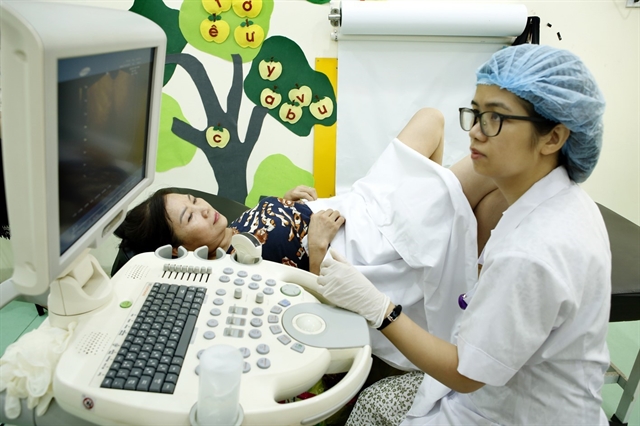 Society
Society

More measures are set to be taken by Hà Nội authorities to improve local population quality.

|
| Reproductive health screenings and family planning consultations, together with medicines and cancer screenings, are provided for free for migrant workers with poor background in the downtown district of Hoàn Kiếm, Hà Nội during an awareness campaign. VNA/VNS Photo Dương Ngọc |
HÀ NỘI — More measures are set to be taken by Hà Nội authorities to improve local population quality.
According to the municipal Department of Health, the city achieved the population and family planning targets set for 2018, including the birth rate reduced by 0.17 per thousand from the previous year to 15.13 per thousand, the number of third children born down by 0.1 per cent, and the sex ratio at birth down to 113 males per 100 females.
While the prenatal screening rate reached 76 per cent of pregnant women, the newborn screening rate rose to 84.1 per cent. Hà Nội also carried out hearing screening for more than 193,390 cases, thalassemia screening for 7,500 cases and congenital heart defect screening for almost 35,360 cases.
Head of the sub-department for population and family planning Tạ Quang Huy noted that in the first half of 2019, about 49,380 babies were born in Hà Nội, up 2,786 from the same period last year. Among these, 3,820 were at least the third child in their families, rising by 252. The sex ratio at birth was 110.9 males per 100 females.
Meanwhile, the prenatal screening rate approximated 81 per cent of pregnant women, and that for newborns surpassed 84 per cent.
He said that Hà Nội had stepped up communication activities and the provision of population-related services in all 30 district-level localities, involving 547 out of the 584 communes, wards and townships.
Refresher courses had been held to improve population knowledge about reproductive healthcare and family planning. Relevant units had also increased examining the management of contraceptive methods in all district-level localities.
Additionally, a number of plans had been implemented to help promote population quality, including those on prenatal and newborn screening, healthcare for the elderly, developing Hanoians’ strength and stature, and engaging the private sector in the provision of birth control methods and family planning services.
However, there remained a number of difficulties facing the city, including high sex ratio at birth, partly due to rapid population growth. In many cases, cadres or civil servants who were familiar with the State’s policies and laws were those giving birth to a third child, Huy noted.
Deputy Director of the municipal Department of Health Hoàng Đức Hạnh, who is also deputy head of Hà Nội’s steering board for population and family planning affairs, said the city had applied many population-related models like those caring for reproductive health of adolescents and youth, and those providing premarital consultation and medical check-ups.
Relevant agencies and organisations had also worked to promote knowledge about reproductive health, family planning and gender equality to workers in industrial parks and women of reproductive age.
In the face of existing difficulties, he stressed the need for more measures to be carried out to improve population quality.
In 2019, the local health sector would work to reduce the birth rate by 0.1 per thousand and the number of third children born by 0.1 per cent year on year. Meanwhile, it would also take actions to raise the number of old people receiving regular health check-ups by 0.6 per cent.
Localities and relevant agencies would also step up dissemination and consultation provision to boost public awareness of population quality and sex ratios at birth, especially among groups at high risk of having a third child, the official noted.
Hạnh added to help narrow the gender gap at birth, authorities had also been ordered to enhance inspection and examination of private health facilities to ensure they comply with legal regulations on population, including refraining from prenatal sex selection. — VNS




